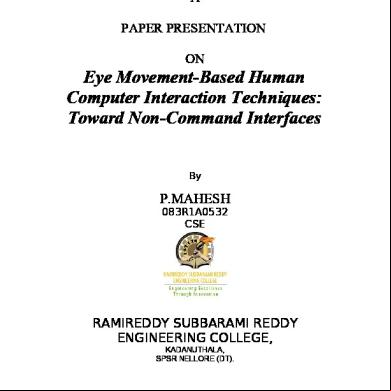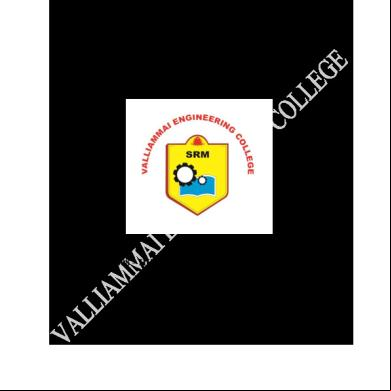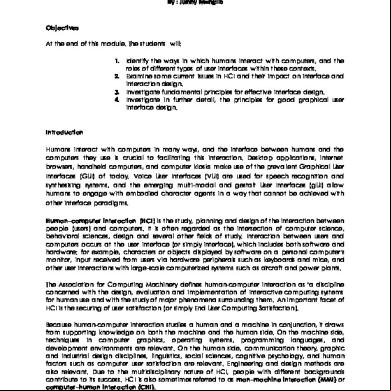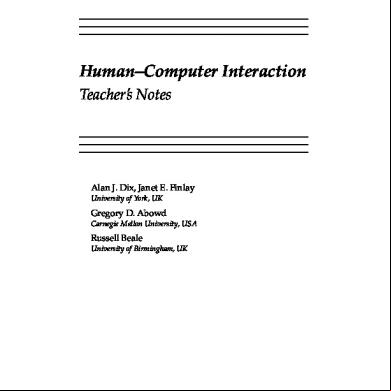Eye Movement-based Human Computer Interaction Techniques 6m2kp
This document was ed by and they confirmed that they have the permission to share it. If you are author or own the copyright of this book, please report to us by using this report form. Report 3b7i
Overview 3e4r5l
& View Eye Movement-based Human Computer Interaction Techniques as PDF for free.
More details w3441
- Words: 1,748
- Pages: 5
A PAPER PRESENTATION ON
Eye Movement-Based Human Computer Interaction Techniques: Toward Non-Command Interfaces By
P.MAHESH 083R1A0532 CSE
RAMIREDDY SUBBARAMI REDDY ENGINEERING COLLEGE, KADANUTHALA, SPSR NELLORE (DT).
ABSTRACT: -computer dialogues are typically one-sided, with the bandwidth from computer to far greater than that from to computer. The movement of a ’s eyes can provide a convenient, natural, and high-bandwidth source of additional input, to help redress this imbalance. We therefore investigate the introduction of eye movements as a computer input medium. Our emphasis is on the study of interaction techniques that incorporate eye movements into the -computer dialogue in a convenient and natural way. It discusses some of the human factors and technical considerations that arise in trying to use eye movements as an input medium, describes our approach and the first eye movement-based interaction techniques that we have devised and implemented experiences and observations on them, and considers eye movement-based interaction as an exemplar of a new, more general class of non-command-based computer interaction.
INTRODUCTION: In searching for better interfaces between s and their computers, an additional modeof communication between the two parties would be of great use. The problem of humancomputer interaction can be viewed as two powerful information processors (human and computer) attempting to communicate with each other via a narrow-bandwidth, highly
constrained interface Faster, more natural, more convenient (and, articularly, more parallel, less sequential) means for s and computers to exchange information are needed to increase the useful bandwidth across that interface. On the ’s side, the constraints are in the nature of the communication organs and abilities with which humans are endowed; on the computer side, the only constraint is the range of devices and interaction techniques that we can invent and their performance. Current technology has been stronger in the computer-to- direction than -to-computer, hence today’s -computer dialogues are typically one-sided, with the bandwidth from the computer to the far greater than that from to computer. We are especially interested in input media that can help redress this imbalance by obtaining data from the conveniently and rapidly. We therefore investigate the possibility of using the movements of a ’s eyes to provide a high-bandwidth source of additional input. While the technology for measuring a ’s visual line of gaze (where he or she is looking in space) and reporting it in real time has been improving, what is needed is appropriate interaction techniques that incorporate eye movements into the -computer dialogue in a convenient and natural way. An interaction technique is a way of using a physical input device to perform a generic task in a humancomputer dialogue Because eye movements are so different from conventional computer inputs, our basic approach to deg interaction techniques has been, wherever possible, to obtain information from the natural movements of the ’s eye while viewing the display, rather
than requiring the to make specific trained eye movements to actuate the system. We therefore begin by studying the characteristics of natural eye movements and then attempt to recognize corresponding patterns in the raw data obtainable from the eye tracker, convert them into tokens with higherlevel meaning, and then build dialogues based on the known characteristics of eye movements. In addition, eye movement-based interaction techniques provide a useful exemplar of a new, non-command style of interaction. Some of the qualities that distinguish eye movementbased interaction from more conventional types of interaction are shared by other newly emerging styles of humancomputer interaction that can collectively be characterized as ‘‘non command-based.’’ In a non-commandbased dialogue, the does not issue specific commands;instead, the computer ively observes the and provides appropriate responses. Non-command-based interfaces will also have a significant effect on interface software because of their emphasis on continuous, parallel input streams and real-time timing constraints, in contrast to conventional single-thread dialogues based on discrete tokens. We describe the simple interface management system and interface description language incorporated into our system and the more general requirements of interface software for highly nteractive, non-command styles of interaction.
NON-COMMAND INTERFACE STYLES: Eye movement-based interaction is one of several areas of current research in humancomputer interaction in which a new interface style seems to be emerging. It represents a change in input from objects for the to actuate by specific commands to ive equipment that simply senses parameters of the ’s body. Jakob Nielsen describes this property as non-command-based:
The fifth generation interface paradigm seems to be centered around noncommand based dialogues. This term is a somewhat negative way of characterizing a new form of interaction but so far, the unifying concept does seem to be exactly the abandonment of the principle underlying all earlier paradigms: That a dialogue has to be controlled by specific and precise commands issued by the and processed and replied to by the computer. The new interfaces are often not even dialogues in the traditional meaning of the word, even though they obviously can be analyzed as having some dialogue content at some level since they do involve the exchange of information between a and a computer. The principles shown at CHI’90 which I am summarizing as being non-command-based interaction are eye tracking interfaces, artificial realities, play-along music accompaniment, and agents. Previous interaction styles–batch, command line, menu, full-screen, natural language, and even current desktop or "WIMP" (window-icon-menu-pointer) styles–all await, receive, and respond to explicit commands from the to the computer. In the non-command style, the computer ively monitors the and responds as appropriate, rather than waiting for the to issue specific commands. This distinction can be a subtle one, since any action, even a non-voluntary one, could be viewed as a command, particularly from the point of view of the software designer. The key criterion should therefore be whether the thinks he or she is issuing an explicit command. It is of course possible to control one’s eye movements, facial expressions, or
gestures voluntarily, but that misses the point of a non command-based interface; rather, it is supposed ively to observe, for example, the ’s natural eye movements, and respond based on them. The essence of this style is thus its non-intentional quality. Following Rich’s taxonomy of adaptive systems, we can view this distinction as explicit vs. implicit commands, thus noncommand really means implicit commands. This style of interface requires the invention of new interaction techniques that are helpful but do not annoy the . Because the inputs are often non-intentional, they must be interpreted carefully to avoid annoying the with unwanted responses to inadvertent actions. For eye movements, we have called this the "Midas Touch" problem, since the highly responsive interface is both a boon and a curse. Our investigation of eye movement-based interaction techniques, described in this chapter, provides an example of how these problems can be attacked.
PERSPECTIVES ON EYE MOVEMENTBASED INTERACTION: As with other areas of interface design, considerable leverage can be obtained by drawing analogies that use people’s already-existing skills for operating in the natural environment and searching for ways to apply them to communicating with a computer. Direct manipulation interfaces have enjoyed great success, particularly with novice
s, largely because they draw on analogies to existing human skills (pointing, grabbing, moving objects in physical space), rather than trained behaviors; and virtual realities offer the promise of usefully exploiting people’s existing physical navigation and manipulation abilities. These notions are more difficult to extend to eye movement-based interaction, since few objects in the real world respond to people’s eye movements. The principal exception is, of course, other people: they detect and respond to being looked at directly and, to a lesser and much less precise degree, to what else one may be looking at. In describing eye movementbased human-computer interaction we can draw two distinctions: one is in the nature of the ’s eye movements and the other, in the nature of the responses. Each of these could be viewed as natural (that is, based on a corresponding realworld analogy) or unnatural (no real world counterpart): • Within the world created by an eye movement-based interface, s could move their eyes to scan the scene, just as they would a real world scene, unaffected by the presence of eye tracking equipment (natural eye movement, on the eye movement axis). The alternative is to instruct s of the eye movementbased interface to move their eyes in particular ways, not necessarily those they would have employed if left to their own devices, in order to actuate the system (unnatural or learned eye movements). • On the response axis, objects could respond to a ’s eye movements in a natural way, that is, the object responds to the ’s looking in the same way real objects do. As noted, there is a limited domain from which to draw such
analogies in the real world. The alternative is unnatural response, where objects respond in ways not experienced in the real world. The natural eye movement/natural response area is a difficult one, because it draws on a limited and subtle domain, principally how people respond to other people’s gaze. Starker and Bolt provide an excellent example of this mode, drawing on the analogy of a tour guide or host who estimates the visitor’s interests by his or her gazes. In the work described in this chapter, we try to use natural (not trained) eye movements as input, but we provide responses unlike those in the real world. This is a compromise between full analogy to the real world and an entirely artificial interface. We present a display and allow the to observe it with his or her normal scanning mechanisms, but such scans then induce responses from the computer not normally exhibited by real world objects. Most previous eye movementbased systems have used learned ("unnatural") eye movements for operation and thus, of necessity, unnatural responses. Much of that work has been aimed at disabled or handsbusy applications, where the cost of learning the required eye movements ("stare at this icon to activate the device") is repaid by the acquisition of an otherwise impossible new ability. However, we believe that the real benefits of eye movement interaction for the majority of s will be in its naturalness, fluidity, low cognitive load, and almost unconscious operation; these benefits are attenuated if unnatural, and thus quite conscious, eye movements are required. The remaining category in unnatural eye movement/natural response, is anomalous and has not been used in practice.
Eye Movement-Based Human Computer Interaction Techniques: Toward Non-Command Interfaces By
P.MAHESH 083R1A0532 CSE
RAMIREDDY SUBBARAMI REDDY ENGINEERING COLLEGE, KADANUTHALA, SPSR NELLORE (DT).
ABSTRACT: -computer dialogues are typically one-sided, with the bandwidth from computer to far greater than that from to computer. The movement of a ’s eyes can provide a convenient, natural, and high-bandwidth source of additional input, to help redress this imbalance. We therefore investigate the introduction of eye movements as a computer input medium. Our emphasis is on the study of interaction techniques that incorporate eye movements into the -computer dialogue in a convenient and natural way. It discusses some of the human factors and technical considerations that arise in trying to use eye movements as an input medium, describes our approach and the first eye movement-based interaction techniques that we have devised and implemented experiences and observations on them, and considers eye movement-based interaction as an exemplar of a new, more general class of non-command-based computer interaction.
INTRODUCTION: In searching for better interfaces between s and their computers, an additional modeof communication between the two parties would be of great use. The problem of humancomputer interaction can be viewed as two powerful information processors (human and computer) attempting to communicate with each other via a narrow-bandwidth, highly
constrained interface Faster, more natural, more convenient (and, articularly, more parallel, less sequential) means for s and computers to exchange information are needed to increase the useful bandwidth across that interface. On the ’s side, the constraints are in the nature of the communication organs and abilities with which humans are endowed; on the computer side, the only constraint is the range of devices and interaction techniques that we can invent and their performance. Current technology has been stronger in the computer-to- direction than -to-computer, hence today’s -computer dialogues are typically one-sided, with the bandwidth from the computer to the far greater than that from to computer. We are especially interested in input media that can help redress this imbalance by obtaining data from the conveniently and rapidly. We therefore investigate the possibility of using the movements of a ’s eyes to provide a high-bandwidth source of additional input. While the technology for measuring a ’s visual line of gaze (where he or she is looking in space) and reporting it in real time has been improving, what is needed is appropriate interaction techniques that incorporate eye movements into the -computer dialogue in a convenient and natural way. An interaction technique is a way of using a physical input device to perform a generic task in a humancomputer dialogue Because eye movements are so different from conventional computer inputs, our basic approach to deg interaction techniques has been, wherever possible, to obtain information from the natural movements of the ’s eye while viewing the display, rather
than requiring the to make specific trained eye movements to actuate the system. We therefore begin by studying the characteristics of natural eye movements and then attempt to recognize corresponding patterns in the raw data obtainable from the eye tracker, convert them into tokens with higherlevel meaning, and then build dialogues based on the known characteristics of eye movements. In addition, eye movement-based interaction techniques provide a useful exemplar of a new, non-command style of interaction. Some of the qualities that distinguish eye movementbased interaction from more conventional types of interaction are shared by other newly emerging styles of humancomputer interaction that can collectively be characterized as ‘‘non command-based.’’ In a non-commandbased dialogue, the does not issue specific commands;instead, the computer ively observes the and provides appropriate responses. Non-command-based interfaces will also have a significant effect on interface software because of their emphasis on continuous, parallel input streams and real-time timing constraints, in contrast to conventional single-thread dialogues based on discrete tokens. We describe the simple interface management system and interface description language incorporated into our system and the more general requirements of interface software for highly nteractive, non-command styles of interaction.
NON-COMMAND INTERFACE STYLES: Eye movement-based interaction is one of several areas of current research in humancomputer interaction in which a new interface style seems to be emerging. It represents a change in input from objects for the to actuate by specific commands to ive equipment that simply senses parameters of the ’s body. Jakob Nielsen describes this property as non-command-based:
The fifth generation interface paradigm seems to be centered around noncommand based dialogues. This term is a somewhat negative way of characterizing a new form of interaction but so far, the unifying concept does seem to be exactly the abandonment of the principle underlying all earlier paradigms: That a dialogue has to be controlled by specific and precise commands issued by the and processed and replied to by the computer. The new interfaces are often not even dialogues in the traditional meaning of the word, even though they obviously can be analyzed as having some dialogue content at some level since they do involve the exchange of information between a and a computer. The principles shown at CHI’90 which I am summarizing as being non-command-based interaction are eye tracking interfaces, artificial realities, play-along music accompaniment, and agents. Previous interaction styles–batch, command line, menu, full-screen, natural language, and even current desktop or "WIMP" (window-icon-menu-pointer) styles–all await, receive, and respond to explicit commands from the to the computer. In the non-command style, the computer ively monitors the and responds as appropriate, rather than waiting for the to issue specific commands. This distinction can be a subtle one, since any action, even a non-voluntary one, could be viewed as a command, particularly from the point of view of the software designer. The key criterion should therefore be whether the thinks he or she is issuing an explicit command. It is of course possible to control one’s eye movements, facial expressions, or
gestures voluntarily, but that misses the point of a non command-based interface; rather, it is supposed ively to observe, for example, the ’s natural eye movements, and respond based on them. The essence of this style is thus its non-intentional quality. Following Rich’s taxonomy of adaptive systems, we can view this distinction as explicit vs. implicit commands, thus noncommand really means implicit commands. This style of interface requires the invention of new interaction techniques that are helpful but do not annoy the . Because the inputs are often non-intentional, they must be interpreted carefully to avoid annoying the with unwanted responses to inadvertent actions. For eye movements, we have called this the "Midas Touch" problem, since the highly responsive interface is both a boon and a curse. Our investigation of eye movement-based interaction techniques, described in this chapter, provides an example of how these problems can be attacked.
PERSPECTIVES ON EYE MOVEMENTBASED INTERACTION: As with other areas of interface design, considerable leverage can be obtained by drawing analogies that use people’s already-existing skills for operating in the natural environment and searching for ways to apply them to communicating with a computer. Direct manipulation interfaces have enjoyed great success, particularly with novice
s, largely because they draw on analogies to existing human skills (pointing, grabbing, moving objects in physical space), rather than trained behaviors; and virtual realities offer the promise of usefully exploiting people’s existing physical navigation and manipulation abilities. These notions are more difficult to extend to eye movement-based interaction, since few objects in the real world respond to people’s eye movements. The principal exception is, of course, other people: they detect and respond to being looked at directly and, to a lesser and much less precise degree, to what else one may be looking at. In describing eye movementbased human-computer interaction we can draw two distinctions: one is in the nature of the ’s eye movements and the other, in the nature of the responses. Each of these could be viewed as natural (that is, based on a corresponding realworld analogy) or unnatural (no real world counterpart): • Within the world created by an eye movement-based interface, s could move their eyes to scan the scene, just as they would a real world scene, unaffected by the presence of eye tracking equipment (natural eye movement, on the eye movement axis). The alternative is to instruct s of the eye movementbased interface to move their eyes in particular ways, not necessarily those they would have employed if left to their own devices, in order to actuate the system (unnatural or learned eye movements). • On the response axis, objects could respond to a ’s eye movements in a natural way, that is, the object responds to the ’s looking in the same way real objects do. As noted, there is a limited domain from which to draw such
analogies in the real world. The alternative is unnatural response, where objects respond in ways not experienced in the real world. The natural eye movement/natural response area is a difficult one, because it draws on a limited and subtle domain, principally how people respond to other people’s gaze. Starker and Bolt provide an excellent example of this mode, drawing on the analogy of a tour guide or host who estimates the visitor’s interests by his or her gazes. In the work described in this chapter, we try to use natural (not trained) eye movements as input, but we provide responses unlike those in the real world. This is a compromise between full analogy to the real world and an entirely artificial interface. We present a display and allow the to observe it with his or her normal scanning mechanisms, but such scans then induce responses from the computer not normally exhibited by real world objects. Most previous eye movementbased systems have used learned ("unnatural") eye movements for operation and thus, of necessity, unnatural responses. Much of that work has been aimed at disabled or handsbusy applications, where the cost of learning the required eye movements ("stare at this icon to activate the device") is repaid by the acquisition of an otherwise impossible new ability. However, we believe that the real benefits of eye movement interaction for the majority of s will be in its naturalness, fluidity, low cognitive load, and almost unconscious operation; these benefits are attenuated if unnatural, and thus quite conscious, eye movements are required. The remaining category in unnatural eye movement/natural response, is anomalous and has not been used in practice.










